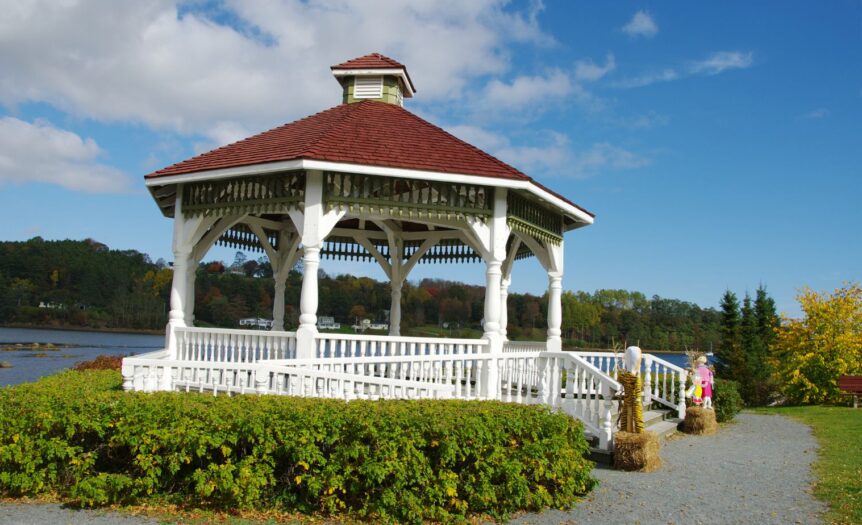Nothing beats the feeling of spending lazy weekends in your backyard. But you know what else can make it better? Sipping a cool drink under the shade of your gazebo. This roofed, open structure provides you with a great view of your surroundings as you enjoy the soft breeze touching your skin.
But before immersing yourself in idyllic bliss, you need to decide on the best roofing material for your outdoor sanctuary. Should you go for the classic look of shingles or opt for the versatility of canvas? Don’t worry, we’ve got you covered.
In this article, we’ll explore the pros and cons of each option to help you find the perfect fit. So, let’s get started.
The Classic Choice
Let’s kick things off by talking about the traditional roofing option: shingles. These are the reasons why shingles have been a popular choice for centuries:
Durability and Longevity
When it comes to these aspects, shingles are hard to beat. This makes them an excellent choice if you’re looking for a long-lasting material for your gazebo. Shingles are designed to withstand a wide range of weather conditions, from scorching heat to heavy rain and snow.
A well-installed shingle roof can last for decades with proper maintenance. That’s why it’s crucial to hire professional contractors like Prairie Exteriors and similar service providers in your area. An expert installation can boost the functionality and beauty of your outdoor shelter.
Aesthetic Appeal
Who says a functional roof can’t be stylish? A shingled gazebo roof exudes charm and beauty. It provides sophistication that canvas roofing can’t match. It also makes your outdoor structure a worthy extension of your home. Whether you’ve chosen classic asphalt or cedar shakes, there’s a perfect look that complements your overall property design.
Increased Property Value
Investing in shingles for your roof can be worthwhile if you’re thinking about selling your home in the future. Appraisers and potential buyers often view additional structures as valuable additions. Just make sure your gazebo stays well-maintained to potentially increase your property’s overall price.
Low Maintenance
Once your shingle roof is installed, it requires relatively little maintenance. Occasional cleaning and annual roof inspections are enough to keep it in good shape. It’s also possible to replace individual shingles rather than the entire roof.
These benefits make shingles your best bet when rooting for a structure that stands the test of time. But they have downsides you might want to consider.
The Drawbacks of Using Shingles for Your Gazebo
While there are numerous reasons for choosing shingles, these aspects might be enough for some homeowners to take a step back:
Cost: Shingles are typically more expensive upfront than canvas options, both in terms of materials and labor costs. Whether made from metal, wood, or asphalt, gazebo shingles will require upfront costs. If you’re looking for ways to make the most of your project, read this guide to help you set a budget for this worthwhile home addition.
Weight: They’re heavier than canvas and require your structure to be sturdy enough to support the additional weight.
Installation complexity: A do-it-yourself (DIY) approach for shingle installation isn’t recommended because of the special tools and skills required.
Revisit your goals and check your budget if you want to determine whether a shingled gazebo roof is meant for you. Otherwise, you can explore another roofing option such as canvas.
The Case for Canvas
A canvas roofing installation might sound impractical, but this material provides some benefits that could appeal to you. So, why consider it?
Versatility
Canvas is widely available and comes in numerous colors, sizes, and patterns. Choosing one lets you match your gazebo to your current outdoor design motif or make a bold statement with a contrasting hue. Want to change things up for the next season? No problem. Canvas is relatively easy to replace giving you the freedom to switch up your outdoor area whenever the mood strikes. That’s why it’s often used in outdoor occasions like weddings, concerts, and more.
Lightweight and Easy to Install
DIY enthusiasts will appreciate how lightweight canvas roofing is. This makes it much easier to handle during installation, especially if you’re working solo or have a small team of helpers. Moreover, this material typically doesn’t require special tools or skills to install.
Cost- Effective
Canvas is friendlier to your wallet. The materials are generally cheaper than shingles, and you’ll save on installation costs, too, if taking the DIY route. If you’re looking to upgrade your backyard without breaking the bank, this is a great option.
Easy Maintenance
Keeping your canvas roof in good condition is simple. Regular cleaning it with a soft brush and mild solution will do. And if a small tear does occur, you can get patching kits at your favorite hardware store.
Affordability and flexibility may seem attractive to some homeowners, but there are things to think about before a canvas roof installation.
The Downsides of Canvas Roofing
While there seems to be a lot going for this fabric, a canvas roof falls short in certain areas:
Shorter Lifespan: While a well-kept canvas roof can last several years, it generally won’t have the same longevity as a shingle roof.
Noise: During heavy rain or hail, canvas roofs can be noisier than their shingle counterparts.
Wind resistance: In areas prone to high winds, canvas may not be as secure as more rigid roofing options.
As a roofing material, canvas provides a good choice for property owners who want to have temporary roofing for their gazebo. However, it’s important to note that canvas isn’t the best choice for areas with extreme weather conditions or heavy snowfall.
Making Your Decision
Now that we’ve laid out the pros and cons of both canvas and shingles, how do you decide which is right for your gazebo? Here are some key factors to consider:
Climate: If you live in an area with extreme weather conditions, shingles might be the better choice. For milder climates, canvas could be perfectly suitable.
Budget: Consider both your upfront costs and long-term investment. While canvas is cheaper initially, you may need to replace it more often than shingles.
Usage: How often will you use your gazebo? For year-round use, shingles might be worth the investment. For seasonal use, canvas could be sufficient.
Aesthetics: Think about the overall look you’re going for in your outdoor space. Do you prefer the sleek, modern look of canvas or the classic appeal of shingles?
DIY vs. Professional Installation: If you’re handy and want to tackle the project yourself, canvas might be more manageable. For shingles, you might need to factor in the cost of professional installation.
Longevity: If you’re planning to stay in your home for many years, the durability of shingles could be appealing. If you like to change things up frequently, the versatility of canvas might be more your style.
Maintenance: Consider how much time and effort you’re willing to put into maintaining your gazebo roof. Both options require some upkeep but a canvas roof might need more frequent attention.
When choosing the best option, take your time, weigh the pros and cons, and envision how each option would fit into your ideal structure. Whichever you choose, the most important thing is to pick one that enhances your outdoor experience.
The Verdict
In the end, there’s no one-size-fits-all answer to the canvas vs. shingles debate. Both options have their merits, and the right choice depends on your unique needs and priorities.
If you’re looking for a budget-friendly roofing solution that caters to frequent design changes, canvas could be the way to go. At the same time, if you require durability, long-term value, and classic appeal, shingles might be a better choice.
Whether you end up with the charm or canvas or the timeless appeal of asphalt, metal, or wood shingles, consider the tips above to create the perfect outdoor sanctuary for you and your loved ones. After all, a gazebo is meant to help you unwind and connect with nature.










